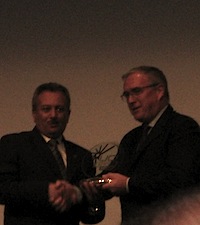 Communication is highly underrated. Take my recent dust-up with The Atlantic over a deleted comment on their not-initially-so-accurate history of blood doping.
Communication is highly underrated. Take my recent dust-up with The Atlantic over a deleted comment on their not-initially-so-accurate history of blood doping.
With no direct contact emails for authors and editors, a reluctance to respond to @replies or Tumblr inquiries, and a Memory Hole-esque contact form as the only institutional recourse, that magazine makes it very hard to open any sort of communication channel. Whether you take this to be intentional or not depends on your level of cynicism—certainly, it’s no way to endear yourself to a blogger.
I did finally manage to get in touch with the author, who actually talked with me to smooth out the wrinkles in the piece, and revealed that—as predicted— the comment had been deleted due to the number of links in it.
While I could question the wisdom of not documenting this anti-spam feature, or of attempting to block commenters who bother to cite their sources, I’ll instead stick with the message that, had the magazine simply been easier to contact, my flaming would have been far less intense, and the article would have been improved a whole lot sooner.
Multiply the difficulty of communicating with The Atlantic by about a billion, and you’ll get roughly the challenge presented by any sort of communication with the UCI. I really do appreciate Michael Ashenden’s NYVelocity interviews, but he shouldn’t be “taken aback by how poorly” both a scientist and a leading cycling publication understand the finer points of the Biological Passport; the UCI has done nothing to communicate them.
The governing body’s own documentation on the project is scattered, nearly illegible (gray on gray!), and hardly detailed. A sparse FAQ, and an in-depth WADA outline for a generic bio passport program leave a lot to be desired. Such total disregard toward informing anyone outside the process (riders, fans, media, researchers for The Atlantic, etc.) is no way to win support for a controversial program, and it probably doesn’t help in the courtroom, either.
 Sure, the UCI isn’t awash in cash. But what would it cost them to hire a freelance writer to untangle that rat’s nest of an FAQ? The RadioShack jersey fine alone would pay for a microsite and a decent design team to create an informative, user-friendly interface for the entire Bio Passport operation, plus a couple of nice infographics to help this pill of a program go down.
Sure, the UCI isn’t awash in cash. But what would it cost them to hire a freelance writer to untangle that rat’s nest of an FAQ? The RadioShack jersey fine alone would pay for a microsite and a decent design team to create an informative, user-friendly interface for the entire Bio Passport operation, plus a couple of nice infographics to help this pill of a program go down.
In fact, if the UCI had any sort of communications savvy, it would be making the entire program—statistical formulae included—completely open for scrutiny and re-use. The AFLD has apparentlyburied the hatchet in its dispute with the UCI, and they’re the only group I could imagine “stealing” a doping suspicion algorithm and setting up a competing project. If the UCI’s blood passport algorithm were made open by design, and then adopted by other sports, the UCI would have an ironclad talking point that cycling was leading the way in the fight against doping.
But sadly, communication is not an art form well-respected in the backhalls of Aigle, where top-down management is fetishized to a point that might just make Josef Stalin blush. One almost gets the feeling that negative user feedback only stiffens the UCI’s resolve to maintain the status quo, if for no other reason than to remind the world that they—and not the athletes, organizers, or fans they allegedly serve—are the real authority around here.
I’d love to attribute this non-communicative stubbornness to the entrenched attitude of privilege inherent in many European governing bodies, but sadly, it seems to pop up wherever a self-conscious authority feels threatened—on either side of The Atlantic.
Yay! I made the blog post! I feel so special now 🙂
Well said. Love your concluding pun.
Sorry, I’m not sold on why the UCI needs to better publicize their process. Maybe I’m missing
Communication can be a source of a lot of problems. Sometimes it is a lack of communication, and sometimes “loose lips sink ships”. With the passport program, I think the UCI needs to keep their cards close to their chest if they hope for it to be effective.
Take the 50% rule. Once imposed, riders magically had hematocrit levels of 47-49% for the majority of the season. Sure, the levels were safer than before, but riders were obviously still doping.
If the UCI publicized their magic formulas and criteria, the riders and their “doctors” will know exactly how much doping they can and can’t get away with. The goal of the passport program is not to put a governor on doping, but to catch cheaters.
Before, cheaters knew exactly how the tests worked, and therefore how to beat them. The passport program has created a fuzzy, undefined line that leaves the cheaters guessing at what they can, and can’t get away with. Can you micro-dose? How much is too much to raise suspicion?
Cosmo and Nathan,
You are entirely missing the point of the Bio Passport program.
It’s theater. They’ve had to add more players as the abuses become more absurd. But it’s still theater. This has been the case since the early EPO days when Juniors were dying of heart attacks.
Take the UCI’s doping powers away, institute a tighter communication firewall between the UCI and WADA and then watch the high-profile positives pile up.
Wow . . . is this a classy cycling blog or what? 🙂